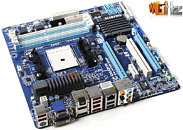- Joined
- Oct 9, 2007
- Messages
- 47,854 (7.38/day)
- Location
- Dublin, Ireland
| System Name | RBMK-1000 |
|---|---|
| Processor | AMD Ryzen 7 5700G |
| Motherboard | Gigabyte B550 AORUS Elite V2 |
| Cooling | DeepCool Gammax L240 V2 |
| Memory | 2x 16GB DDR4-3200 |
| Video Card(s) | Galax RTX 4070 Ti EX |
| Storage | Samsung 990 1TB |
| Display(s) | BenQ 1440p 60 Hz 27-inch |
| Case | Corsair Carbide 100R |
| Audio Device(s) | ASUS SupremeFX S1220A |
| Power Supply | Cooler Master MWE Gold 650W |
| Mouse | ASUS ROG Strix Impact |
| Keyboard | Gamdias Hermes E2 |
| Software | Windows 11 Pro |
AMD's new Fusion A-Series "Llano" accelerated processing unit (APU) is shaping up to be a credible home and entertainment platform, but it is also carrying the responsibility of making it to office spaces. Part of that initiative would rest with the motherboard manufacturers to come up with inexpensive and durable sub-$100 motherboards that can be bought and deployed in bulk. Enter the Gigabyte A75M-UD2H. This micro-ATX form-factor motherboard relies entirely on the platform's feature-set.
The FM1 APU socket is powered by a simple 4+1 phase VRM, it is wired to four DDR3 DIMM slots supporting dual-channel DDR3-1600 MHz memory. Of the four expansion slots, there's one PCI-Express 2.0 x16, a PCI-E x16 that's electrical x4, and one each of PCI-E x1 and legacy PCI. To further make for its business PC outlook, there are headers for legacy ports such as LPT and COM (for dot-matrix printers in banks, etc.).



To ensure that HTPC builders aren't left out, there's all the connectivity consumers will ever need, with display outputs including one each of D-Sub, DVI, HDMI 1.4a, and DisplayPort 1.2; 8+2 channel HD audio driven by high-grade Realtek ALC889A CODEC; four USB 3.0 ports (two rear, two via header); storage connectivity that includes five internal SATA 6 Gb/s supporting RAID, one power-eSATA 6 Gb/s; and FireWire. Expect the Gigabyte A75M-UD2H to be a part of the company's first-wave of socket FM1 motherboards.
View at TechPowerUp Main Site
The FM1 APU socket is powered by a simple 4+1 phase VRM, it is wired to four DDR3 DIMM slots supporting dual-channel DDR3-1600 MHz memory. Of the four expansion slots, there's one PCI-Express 2.0 x16, a PCI-E x16 that's electrical x4, and one each of PCI-E x1 and legacy PCI. To further make for its business PC outlook, there are headers for legacy ports such as LPT and COM (for dot-matrix printers in banks, etc.).



To ensure that HTPC builders aren't left out, there's all the connectivity consumers will ever need, with display outputs including one each of D-Sub, DVI, HDMI 1.4a, and DisplayPort 1.2; 8+2 channel HD audio driven by high-grade Realtek ALC889A CODEC; four USB 3.0 ports (two rear, two via header); storage connectivity that includes five internal SATA 6 Gb/s supporting RAID, one power-eSATA 6 Gb/s; and FireWire. Expect the Gigabyte A75M-UD2H to be a part of the company's first-wave of socket FM1 motherboards.
View at TechPowerUp Main Site




